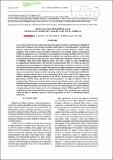| dc.contributor.author | Some, E.S. | |
| dc.contributor.author | Koech, D.K. | |
| dc.contributor.author | Ochogo, J.O. | |
| dc.contributor.author | Ocholla, F | |
| dc.contributor.author | Mumbi, F | |
| dc.date.accessioned | 2022-01-20T14:47:19Z | |
| dc.date.available | 2022-01-20T14:47:19Z | |
| dc.date.issued | 1997-09 | |
| dc.identifier.citation | Some ES, Koech DK, Ochogo JO, Ocholla F, Mumbi F. An evaluation of surveillance of malaria at primary health care level in Kenya. East Afr Med J. 1997 Sep;74(9):573-5. PMID: 9487433. | en_US |
| dc.identifier.other | Vol. 74 No. 9 | |
| dc.identifier.other | PMID: 9487433 | |
| dc.identifier.uri | https://repository.amref.ac.ke/handle/123456789/514 | |
| dc.description | Explorative study | en_US |
| dc.description.abstract | As less than twenty five per cent of persons suffering from malaria seek formal treatment in most of sub-Saharan Africa, Facility-based morbidity statistics are inadequate for monitoring malaria control programmes. This explorative study assessed whether a health centre equipped with a microscope and trained personnel could monitor malaria transmission within its catchment area. The study was conducted at Chemase Health Centre in Nandi District in Kenya, an area holoendemic for malaria with Anopheles gambiae as the main vector and Plasmodium falciparum as the commonest cause of malaria. From first August to 31 October 1991, first seven children under five years of age on each working day accompanied by their mothers to the maternal and child health clinic were studied. A general examination was performed by a Registered Clinical Officer (Medical Assistant) and thin and thick blood smears made, stained with Giemsa stain and examined for malaria parasites by a Medical Laboratory Technologist. Mothers were interviewed by enrolled community nurses on antimalarial measures they were using in their homes. Four hundred and fifty five children mostly under five years of age, consisting of 48.1% males and 51.9% females, were studied. Malaria parasites were present in 209 (45.9%) blood smears of the children. The percentage of blood smears positive for malaria parasites was high in children below 36 months of age. There was a tendency for low percentage of blood smears positive for malaria in children whose mothers reported using mosquito nets or insecticide sprays. The study did not interrupt the routine of the health centre. Periodic monitoring of new malaria illnesses. and percentage of blood smears positive for malaria parasites in children aged 0 to 35 months should be introduced into health centre practice in Kenya. This catchment area approach could be used to monitor malaria control programmes as well as predicting malaria epidemics. | en_US |
| dc.description.sponsorship | DVBD, and Chemase Health Centre | en_US |
| dc.publisher | East African Medical Journal | en_US |
| dc.subject | Nandi District | en_US |
| dc.subject | Kenya | en_US |
| dc.subject | Holoendemic | en_US |
| dc.subject | Anopheles | en_US |
| dc.subject | Plasmodium falciparum | en_US |
| dc.subject | Community | en_US |
| dc.title | An Evaluation of Surveillance of Malaria at Primary Health Care in Kenya | en_US |

